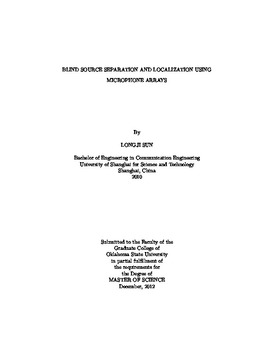| dc.contributor.author | Sun, Longji | |
| dc.date.accessioned | 2014-04-17T20:12:41Z | |
| dc.date.available | 2014-04-17T20:12:41Z | |
| dc.date.issued | 2012-12-01 | |
| dc.identifier.uri | https://hdl.handle.net/11244/10318 | |
| dc.description.abstract | The blind source separation and localization problem for audio signals is studied using microphone arrays. Pure delay mixtures of source signals typically encountered in outdoor environments are considered. Our proposed approach utilizes the subspace methods, including multiple signal classification (MUSIC) and estimation of signal parameters via rotational invariance techniques (ESPRIT) algorithms, to estimate the directions of arrival (DOAs) of the sources from the collected mixtures. Since audio signals are generally considered broadband, the DOA estimates at frequencies with the large sum of squared amplitude values are combined to obtain the final DOA estimates. Using the estimated DOAs, the corresponding mixing and demixing matrices are computed, and the source signals are recovered using the inverse short time Fourier transform. Subspace methods take advantage of the spatial covariance matrix of the collected mixtures to achieve robustness to noise. While the subspace methods have been studied for localizing radio frequency signals, audio signals have their special properties. For instance, they are nonstationary, naturally broadband and analog. All of these make the separation and localization for the audio signals more challenging. Moreover, our algorithm is essentially equivalent to the beamforming technique, which suppresses the signals in unwanted directions and only recovers the signals in the estimated DOAs. Several crucial issues related to our algorithm and their solutions have been discussed, including source number estimation, spatial aliasing, artifact filtering, different ways of mixture generation, and source coordinate estimation using multiple arrays. Additionally, comprehensive simulations and experiments have been conducted to examine various aspects of the algorithm. Unlike the existing blind source separation and localization methods, which are generally time consuming, our algorithm needs signal mixtures of only a short duration and therefore supports real-time implementation. | |
| dc.format | application/pdf | |
| dc.language | en_US | |
| dc.publisher | Oklahoma State University | |
| dc.rights | Copyright is held by the author who has granted the Oklahoma State University Library the non-exclusive right to share this material in its institutional repository. Contact Digital Library Services at lib-dls@okstate.edu or 405-744-9161 for the permission policy on the use, reproduction or distribution of this material. | |
| dc.title | Blind Source Separation and Localization Using Microphone Arrays | |
| dc.type | text | |
| osu.filename | Sun_okstate_0664M_12511.pdf | |
| osu.college | Engineering, Architecture, and Technology | |
| osu.accesstype | Open Access | |
| dc.description.department | School of Materials Science & Engineering | |
| dc.type.genre | Thesis | |
| dc.subject.keywords | blind source separation and localization | |
| dc.subject.keywords | esprit | |
| dc.subject.keywords | microphone arrays | |
| dc.subject.keywords | music | |
| dc.subject.keywords | subspace methods | |
